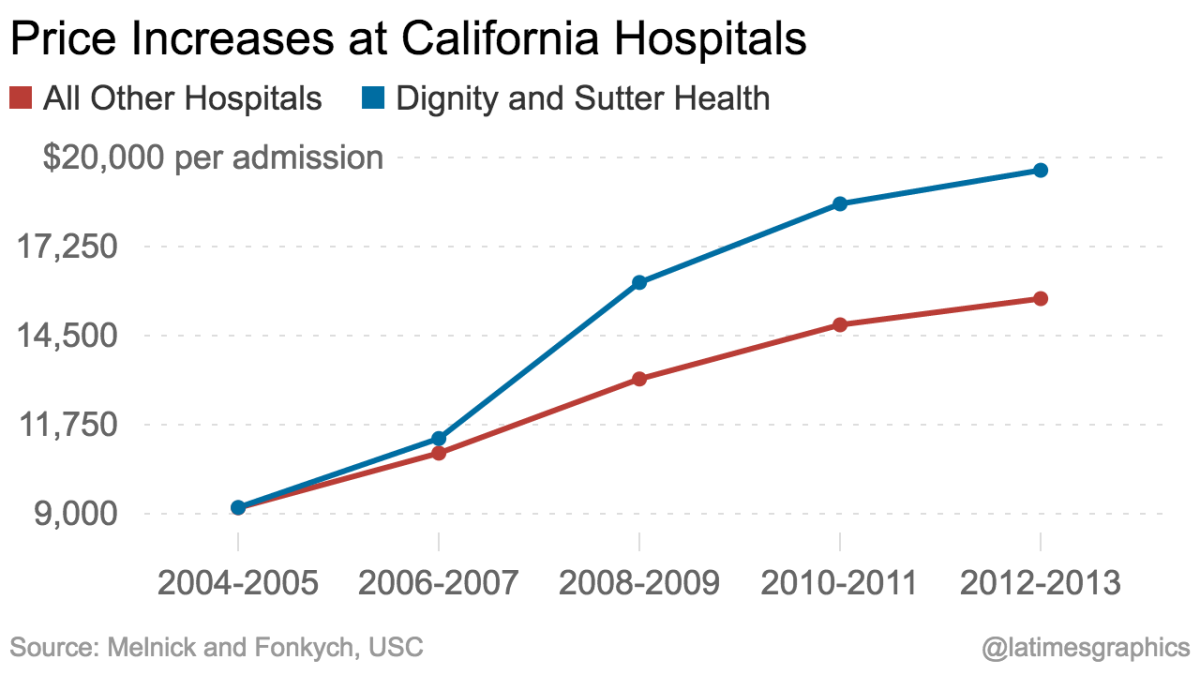Column: A warning on hospital mergers: After California allowed big chains to grow, prices soared
- Share via
The debate over hospital mergers traditionally has focused on whether allowing hospitals within a local community to merge drives up prices in that community. A new study from the University of Southern California sounds a much louder alarm.
The study found that the domination of the state’s hospital segment by two big systems, Sutter Health and Dignity Health, not only drove up prices everywhere their institutions were located but allowed even nonaffiliated hospitals to charge more. That’s a warning for policymakers at the federal level and in many states, where hospital mergers are on the rise.
Hospital prices ... increased substantially in California during a period of low overall price inflation, low economic growth, and declining demand.
— Melnick and Fonkych, USC
“What happened in California is now happening across the country,” says Glenn Melnick, a professor of healthcare finance at USC and co-author, with Katya Fonkych, of the study. Their article appears in the Journal of Health Care Organization, Provision and Financing. (Hat-tip to Chad Terhune of Kaiser Health News.)
Sutter and Dignity are among California’s largest healthcare systems, with Dignity controlling 26 hospitals and other medical facilities across the state, and Sutter operating 24 hospitals and other facilities, almost exclusively in Northern California. Both are nonprofits but firmly in the black: Sutter reported $81 million in net income on $11 billion in revenue last year, and Dignity reported net income of $558 million on revenue of $12.4 billion for the year ended June 30, 2015.
They’re both beneficiaries of California’s historically tolerant approach to hospital mergers. As Melnick and Fonkych observe, almost half of California hospitals have been in a multi-hospital system since 2004. Many of these combinations were permitted on the argument that merged institutions would operate more efficiently and be better positioned to control cost and price hikes. The study undermines that assertion.

Using claims data from Blue Shield of California, Melnick and Fonkych found that the insurer’s payments per patient admission to Dignity and Sutter institutions had increased by 113% from 2003-2004 through 2012-2013. Payments to nonaffiliated hospitals, some of which were in smaller systems, increased 76%. Both trends exceeded overall inflation, and took place during a period of low economic growth and declining demand for inpatient services — which should have suppressed price increases.
Sutter and Dignity disputed the findings. Bill Gleeson, a Sutter spokesman, observed that Sutter has been in longstanding conflict with Blue Shield and called the study “a self-serving play by Blue Shield to use stale and potentially misleading data to further its negotiations and attempt to advance its position in pending litigation with Sutter Health.” He said that competition remains vigorous throughout Sutter’s market. He said the study uses “outdated” data that don’t reflect “the current environment.” Dignity said through a spokesman that “the California healthcare marketplace is very competitive.”
The pricing power of large hospital systems has been investigated by California Atty. Gen. Kamala Harris, who reportedly issued subpoenas to Dignity, Sutter, and at least one other system in 2012. Nothing has come of her inquiry yet, however.
The USC researchers attributed the price increases to big systems’ ability to magnify their market power, even when they weren’t the only providers in town. First, they can impose “all or nothing” contracts on insurers — in order to gain access to a handful of “must-have” institutions, insurers must agree to contract with all or most of a chain’s hospitals.
The large footprint of big chains can give them immense leverage in negotiations with insurers. That became an issue in 2014, when some 280,000 Blue Shield members became the pawns in a battle between the insurer and Sutter; if no agreement could be reached, many were faced with the prospect of changing hospitals.
“If you’re an insurer selling peace of mind,” Melnick observes, “do you want to have to find a new place to get treatment for hundreds of thousands of people?” Blue Shield and Sutter finally reached an agreement that expires at the end of this year.
Big hospital systems can also impose gag clauses, which make it harder for health plans to share data with their own employer clients, Melnick and Fonkych observe. According to a notice that Anthem Blue Cross sent to its employer customers in February, for example, employers must sign an arbitration and confidentiality agreement demanded by Sutter in order to have access to Sutter hospitals at in-network rates. The agreement prohibits employers from disclosing the Anthem/Sutter contract to any third parties.
The Pacific Business Group on Health, a consortium of Northern California employers, has said in court filings that the employers may not have the option to refuse to sign the agreement. Having a hospital network that doesn’t include Sutter facilities “is not economically feasible,” given the systems penetration in the region. But nor is it feasible to pay at “non-contract, out-of-network rates,” which are significantly higher than the in-network prices — which are themselves higher for Sutter hospitals than others.
What may be most alarming about the USC study is indications that the pricing power of Sutter and Dignity allowed non-system hospitals to raise rates too. “If I’m in the same market as Sutter,” Melnick says, “I can tell an insurer that I want [to be paid] more, but still be a lower-cost option compared to Sutter.”
Addressing this market power may fall to the legislature, Melnick says. The state could outlaw the ability of large system to negotiate all-or-nothing deals, or forbid confidentiality clauses. But the best remedy may be prevention — not allowing systems to grow big in the first place.
Keep up to date with Michael Hiltzik. Follow @hiltzikm on Twitter, see his Facebook page, or email [email protected].
Return to Michael Hiltzik’s blog.
UPDATES:
3:34 p.m.: This post has been updated with further details of the Sutter confidentiality agreement.







